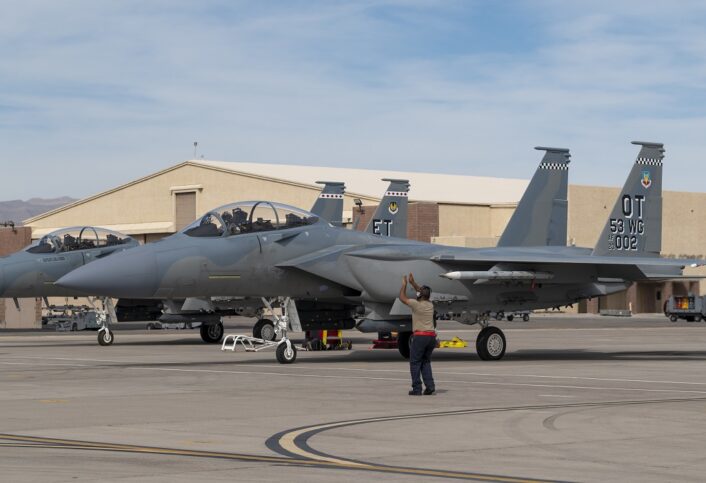The TNI AU is looking to overhaul its variegated aircraft fleet, currently made of F-16s, Su-27s, Su-30 and Hawk light fighters/trainers.
Indonesia and France signed a deal for 42 latest-generation Rafale fighter aircraft, during a ceremony held on Feb. 10, 2022, in Jakarta. The contract includes a “complete turnkey solution”, with a comprehensive package that covers aircrew training, logistical support for several Indonesian air bases, and a training center with two full-mission simulators.
The high-level ceremony was attended by the French Minister of the Armed Forces, Florence Parly, the Indonesian Minister of Defence, Prabowo Subianto, the CEO of Dassault Aviation, Eric Trappier, and the Air Vice Marshal Yusuf Jauhari, Head of Defence Facilities Agency of the Indonesian Ministry of Defence. The Tentara Nasional Indonesia Angkatan Udara (Indonesian National Army Air Force) now effectively becomes the seventh export operator for the French fighter jet.
The TNI AU currently operates a mixed fleet of Russian, US and British hardware, with Su-27SK and Su-30 (MK and MK2), F-16s (both A/B and C/D variants), and Hawk light fighters/trainers (Mk 109 and Mk 209). The Hawks seem to be the ones that will be replaced by the new French aircraft, according to info circulating online.
So the Indonesian Air Force has agreed a deal for a whopping 42 @Dassault_OnAir #Rafales! Deliveries of first six jets within three years. To replace the two Hawk squadrons. Those French know how to sell fighters! Was it a TNI-AU decision or political ? 😳@florence_parly
— Alan Warnes (@warnesyworld) February 10, 2022
During the last few years, reports about potential purchases by Indonesia were frequent, including F-16 Block 72 deals, second-hand Eurofighter Typhoons acquired from Austria, and new Su-35s. The latter saw some resistance from the United States, which threatened to use the CAATSA (Countering America’s Adversaries by Sanctions Act) against Indonesia should they have proceeded forward with the deal.
There is still some uncertainty about the number of Rafales on order. The press release from Dassault mentions a contract for 42 aircraft, while the French newspaper La Tribune says that the contract signed in Jakarta covers only the first six aircraft and the one for the other 36 will be signed later. No info has been disclosed about the timeline of the program and the deliveries.
The latest-generation Rafale mentioned in the official press release (and the same destined to UAE) should be the Rafale F4. This will include upgrades of existing capabilities, like the Thales RBE2 AESA radar, the Spectra electronic warfare system, the OSF IRST, the Thales Talios targeting pod, the Reco NG reconnaissance pod and the communications suite. However, there will be also important new capabilities, like the Helmet Mounted Display, the MICA Next-Generation air-to-air missile and the new 1000 kg variant of the Safran AASM “Hammer” Precision-Guided Munition.

Hours after the announcement of the Rafale purchase, the U.S. Defense Security Cooperation Agency disclosed the approval of a possible Foreign Military Sale to Indonesia for up to 36 F-15EX Eagle II, which will be designated F-15ID. The F-15EX emerged last year as one of the possible choices together with the Rafale, however it is not known right now if the Indonesian government will proceed with the purchase of both fighters.
Notably, the proposed F-15ID will come with the AN/APG-82(v)1 Advanced Electronically Scanned Array (AESA) radars, AN/ALQ-250 Eagle Passive Active Warning Survivability Systems (EPAWSS), Advanced Display Core Processor (ADCP) II digital computers, Joint Helmet Mounted Cueing Systems (JHMCS) for both pilots and Weapon Systems Officers (WSO), AN/AAQ-13 LANTIRN navigation pods, AN/AAQ-33 Sniper Advanced Targeting Pods (ATP), MS-110 Recce Pods, AN/ASG-34 Infrared Search and Track International (possibly integrated in the Sniper’s pylon).
It is interesting to note the presence of the EPAWSS in the equipment list, as it was previously considered a US-only system. The ALQ-250 is an advanced electronic warfare and electronic surveillance system, which is fully integrated with radar warning, geo-location and increased chaff and flare capability to detects and defeat surface and airborne threats in signal-dense and highly contested environments, according to BAE Systems.
The F-15EX has plenty of computing power, thanks to the Advanced Display Core Processor II, reportedly the fastest mission computer ever installed on a fighter jet. This, together with the multiple radios and datalinks, allows the Eagle II to be easily integrated in networked scenarios with other aircraft. The network capabilities are the basis of current and future combat scenarios and are shared also with the Rafale already on order. According to the French DGA, improving the connectivity of the Rafale and the associated networked employment methods, both in a national and allied context, is the primary goal of the F4 standard.
Indonesia is in a strategic position in the light of the great power competition with China, and it should be no wonder that the United States and France are willing to equip the TNI AU with their newest fighter jets. This was also mentioned in the DSCA notice: “This proposed sale will support the foreign policy goals and national security objectives of the United States by improving the security of an important regional partner that is a force for political stability, and economic progress in the Asia-Pacific region. It is vital to U.S. national interest to assist Indonesia in developing and maintaining a strong and effective self-defense capability. The proposed sale will improve Indonesia’s capability to meet current and future threats by enabling it to provide increased deterrence and air defense coverage across a very complex air and maritime domain. Indonesia will have no difficulty absorbing these aircraft and equipment into its armed forces.”









